Sissejuhatus infotehnoloogiasse
1.
Sissejuhatus infotehnoloogiasse-1-
2. Loengu ülevaade
Kordamine:II maailmasõja aegsed esimesed arvutid
Raadiolampide tööpõhimõte
1947-1960
Transistor
Arvutite tööstuslik tootmine, IBM-i domineerimine
Kõvakettad
Integraalskeemid
SAGE: sõjaväe radarivõrk
Fortran
1961-1970: Kaasaegse tehnoloogia sünd
Programmeerimiskeeled: Cobol, Lisp (Fortran paar aastat varem)
Dec, PDP ja miniarvutite teke
IBM System 360 mainframed
Integraalskeemide tootmise algus
Engelbart, hiir ja aknad
Esimene mikroprotsessor
UNIX
Laserprinter
-2-
3. First operative digital computers
Five first operative digital computersComputer
Shown working Binary Electronic Programmable
Zuse
May 1941
Yes
No
By punched film stock
Turing complete
Atanasoff–Berry Computer Summer 1941
Yes
Yes
No
Yes (1998)
No
Colossus
1943 / 1944
Harvard Mark I – IBM ASCC
ENIAC
Yes
Yes
Partially, by rewiring
No
1944 No
No
By punched paper tape
Yes (1998)
1944 No
1948 No
Yes
Yes
Partially, by rewiring
-3-
Yes
By Function Table ROM Yes
4. Kordamine: raadiolambi tööpõhimõte
Vacuum Tube (1906, Lee Deforest)Three elements device used as
electronic switch and amplifier: two
electrodes separated by a grid in a
vacuum glass enclosure.
Grid
Principle
Cathode - emits electrons;
Plate (anode) - receives the electrons;
Grid - with negative bias voltage repels
some of the electrons and prevents them
from reaching the plate, resulting in less
current flow. A changing negative charge on
the grid modulates the plate current.
-4-
Cathode
Anode
5. 1947
Three scientists at Bell Telephone Laboratories, William Shockley,Walter Brattain, and John Bardeen demonstrate their new invention of
the point-contact transistor amplifier.
-5-
6. Transistori tööpõhimõte
TransistorThree elements solid-state device for
amplifying, controlling electrical
signals.
Principle
Current flows from emitter through
base into collector;
Switching - Base current on, collector
current flows - Switching;
Amplification - Base current regulates
large amount of collector current.
-6-
I
Emitter
Base
Collector
N
P
N
I
7. 1949
Maurice Wilkes assembled the EDSAC, the first practical storedprogram computer, at Cambridge University. His ideas grew out of theMoore School lectures he had attended three years earlier. For
programming the EDSAC, Wilkes established a library of short
programs called subroutines stored on punched paper tapes.
TECHNOLOGY: vacuum tubes
MEMORY: 1K words, 17 bits, mercury delay line
SPEED: 714 operations per second
-7-
8. 1950
Engineering Research Associates of Minneapolis built the ERA 1101,the first commercially produced computer; the company's first
customer was the U.S. Navy.
It held 1 million bits on its magnetic drum, the earliest magnetic
storage devices. Drums registered information as magnetic pulses in
tracks around a metal cylinder. Read/write heads both recorded and
recovered the data. Drums eventually stored as many as 4,000 words
and retrieved any one of them in as little as five-thousandths of a
second.
-8-
9. 1951
The UNIVAC I delivered to the U.S. Census Bureau was the firstcommercial computer to attract widespread public attention.
Although manufactured by Remington Rand, the machine often was
mistakenly referred to as the "IBM UNIVAC." Remington Rand
eventually sold 46 machines at more than $1 million each.
SPEED: 1,905 operations per second
INPUT/OUTPUT: magnetic tape, unityper, printer
MEMORY SIZE: 1,000 12-digit words in delay lines
MEMORY TYPE: delay lines, magnetic tape
TECHNOLOGY: serial vacuum tubes, delay lines, magnetic tape
FLOOR SPACE: 943 cubic feet
COST: F.O.B. factory $750,000 plus
-9-
10. Early AI programs: checkers, chess (Britain)
Early AI programs: checkers, chess (Britain)Strachey wrote a checkers program for the Ferranti Mark I at
Manchester (with Turing's encouragement and utilising the latter's
recently completed Programmers' Handbook for the Ferranti computer).
By the summer of 1952 this program could, Strachey reported, "play a
complete game of Draughts at a reasonable speed".
Prinz's chess program, also written for the Ferranti Mark I, first ran in
November 1951. It was for solving simple problems of the mate-in-two
variety. The program would examine every possible move until a
solution was found. On average several thousand moves had to be
examined in the course of solving a problem, and the program was
considerably slower than a human player.
Turing started to program his Turochamp chess-player on the Ferranti
Mark I but never completed the task. Unlike Prinz's program, the
Turochamp could play a complete game and operated not by exhaustive
search but under the guidance of rule-of-thumb principles devised by
Turing.
- 10 -
11. Early AI programs: checkers (USA)
Early AI programs: checkers (USA)The first AI program to run in the U.S. was also a checkers
program, written in 1952 by Arthur Samuel of IBM for the IBM
701.
Samuel took over the essentials of Strachey's program (which
Strachey had publicised at a computing conference in Canada in
1952) and over a period of years considerably extended it.
In 1955 he added features that enabled the program to learn
from experience, and therefore improve its play. Samuel included
mechanisms for both rote learning and generalisation. The
program soon learned enough to outplay its creator. Successive
enhancements that Samuel made to the learning apparatus
eventually led to the program winning a game against a former
Connecticut checkers champion in 1962 (who immediately
turned the tables and beat the program in six games straight).
- 11 -
12. 1952
Heinz Nixdorf founded Nixdorf Computer Corp. in Germany. It remainedan independent corporation until merging with Siemens in 1990.
A complaint is filed against IBM, alleging monopolistic practices in its
computer business, in violation of the Sherman Act.
G. W. Dummer, a radar expert from Britain's Royal Radar Establishment
presents a paper proposing that a solid block of materials be used to
connect electronic components, with no connecting wires.
- 12 -
13. 1953
IBM shipped its first electronic computer, the 701.Speedcoding: John Backus.
- 13 -
14. 1954
Texas Instruments announces the start of commercial production onsilicon transistors. [110]
Herbert Simon and Allen Newell unveiled Logic Theorist software
that supplied rules of reasoning and proved symbolic logic theorems.
The Logic Theorist, as the program became known, was the major
exhibit at a conference organised in 1956 at Dartmouth College, New
Hampshire, by John McCarthy, who subsequently became one of the
most influential figures in AI.
Newell, Simon and Shaw went on to construct the General Problem
Solver, or GPS. The first version of GPS ran in 1957 and work continued
on the project for about a decade. GPS could solve an impressive
variety of puzzles, for example the "missionaries and cannibals"
problem.
- 14 -
15. 1955
William Shockley founds Shockley Semiconductor in Palo Alto,California
However, the venture did
not go well, partly because
of Shockley's managerial
style, and partly because
he diverted resources away
from transistor technology
and into the creation of a
4-layer switching diode, a
device which he had
conceived whilst still at Bell.
- 15 -
16. Side note: Stanford University in Palo Alto
- 16 -17. Side note: Hewlett Packard
HP is recognized as the symbolic founder of Silicon ValleyStarted in this garage in Palo Alto
In 1939
Oscillator HP200A was the first
product of HP
- 17 -
18. Side note: Palo Alto in Silicon Valley
PaloAlto
- 18 -
19. 1956
A U.S. District Court makes a final judgement on the complaintagainst IBM filed in January 1952 regarding monopolistic practices. A
"consent decree" is signed by IBM, placing limitations on how IBM
conducts business with respect to "electronic data processing
machines".
IBM develops the first hard disk, the RAMAC 305, with 50 two-foot
diameter platters. Total capacity is 5 MB. (350 Disk Storage Unit)
The first transistorized computer is completed, the TX-O
(Transistorized Experimental computer), at the Massachusetts Institute
of Technology.
The Nobel Prize in physics is awarded to John Bardeen, Walter
Brattain, and William Shockley for their work on the transistor.
- 19 -
20. 1957…
A new language, FORTRAN (short for formula translator), enabled acomputer to perform a repetitive task from a single set of instructions by
using loops.
The first commercial FORTRAN
program ran at Westinghouse,
producing a missing comma
diagnostic.
A successful attempt followed.
- 20 -
21. … 1957
A group of eight engineers leaves Shockley Semiconductor to formFairchild Semiconductors.
Kenneth Olsen founds
Digital Equipment Corporation.
- 21 -
22. 1958
SAGE -- Semi-Automatic Ground Environment -- linked hundreds ofradar stations in the United States and Canada in the first large-scale
computer communications network.
- 22 -
23. 1958
At Texas Instruments, Jack St. Clair Kilby comes up with the idea ofcreating a monolithic device (integrated circuit) on a single piece of
silicon.
Later (in 2000) Kilby receives Nobel
price in physics
Jack Kilby completes building
the first integrated circuit, containing
five components on a piece of germanium
half an inch long and thinner than a toothpick.
- 23 -
24. 1959
Fairchild Semiconductor files a patent application for the planarprocess for manufacturing transistors. The process makes
commercial production of transistors possible and leads to Fairchild's
introduction, in two years, of the first integrated circuit.
Texas Instruments announces the discovery of the integrated circuit.
At Fairchild Semiconductor, Robert Noyce constructs an integrated
circuit with components connected by aluminum lines on a silicon-oxide
surface layer on a plane of silicon.
Fairchild Semiconductor announces their independent discovery of
the integrated circuit.
- 24 -
25. 1960
IBM develops the first automatic mass-production facility fortransistors, in New York.
AT&T designed its Dataphone, the first commercial modem,
specifically for converting digital computer data to analog signals for
transmission across its long distance network
- 25 -
26. 1960
A team drawn from several computer manufacturers and the Pentagondeveloped COBOL, Common Business Oriented Language. Project
leader: Grace Hopper.
LISP made its debut as the first computer language designed for writing
artificial intelligence programs. Inventor: John McCarthy.
- 26 -
27. 1960 DEC PDP-1: MIT TX project aftermath
The PDP-1 sold for $120,000. MIT wrote the first video game, SpaceWar! for it. A total of 50 were built. Each had a cathode ray tube
graphic display.
No real commercial success
- 27 -
28. 1961
Fairchild Semiconductor releases the first commercial integratedcircuit.
According to Datamation magazine, IBM had an 81.2-percent share of
the computer market in 1961, the year in which it introduced the 1400
Series.
The 1401 mainframe, the first in the
1400 series, used transistors instead
of vacuum tubes, and had a magnetic
core memory. More than 12,000 of the
1401 computers were sold.
- 28 -
29. 1962
Teletype ships its Model 33 keyboard and punched-tape terminal, usedfor input and output on many early microcomputers.
Ivan Sutherland creates a graphics system called Sketchpad.
- 29 -
30. 1963
Douglas Engelbart receives a patent on the mouse pointing device forcomputers.
ASCII -- American Standard Code for Information Interchange -permitted machines from different manufacturers to exchange data
Digital Equipment sells its first minicomputer, to Atomic Energy of
Canada.
- 30 -
31. 1964 …
Ian Sharp and others found I.P. Sharp Associates, in Canada.IBM announced System/360, a family of six mutually compatible
computers and 40 peripherals that could work together.
- 31 -
32. …1964
Gordon Moore suggests that integrated circuits would double incomplexity every year. This later becomes known as Moore's Law.
Gordon E. Moore
1929 1950 B.S. in Chemistry
1954 Ph.D. from Cal Tech
1954-1957 Shockley Semiconductor
1957 Co-Founder of Fairchild
Semiconductors
1965 Moore’s Law
1968 Moore, Noyce and Grove left
Fairchild Semiconductors and
founded Intel Corp.
1968-1997 Intel’s president
President
- 32 -
33. Moore’s law
Moore’s Law(1965)
Circuits per chip
=2
(year-1975) / 1.5
“Each new chip contains roughly twice as much capacity as its
predecessor, and is released within 18-24 months of the
previous chip.”
- 33 -
34. …1964
CDC's 6600 supercomputer, designed by Seymour Cray, performedup to 3 million instructions per second -- a processing speed three times
faster than that of its closest competitor, the IBM Stretch.
John Kemeny and Thomas Kurtz develop the BASIC programming
language at Dartmouth College. BASIC is an acronym for Beginners Allpurpose Symbolic Instruction Code.
Texas Instruments receives a patent on the integrated circuit.
- 34 -
35. 1965
Digital Equipment Corp (abbreviated DEC) introduced the PDP-8, thefirst commercially successful minicomputer. The PDP-8 sold for
$18,000, one-fifth the price of a small IBM 360 mainframe. The speed,
small size, and reasonable cost enabled the PDP-8 to go into thousands
of manufacturing plants, small businesses, and scientific laboratories.
- 35 -
36. 1966
Steven Gray founds the Amateur Computer Society, and beginspublishing the ACS Newsletter. Some consider this to be the birth-date
of personal computing.
International Research Corp. is incorporated by Wayne Pickette as a
one man, California corporation. Purpose, to research educational
resources and technological improvements for education
- 36 -
37. 1967…
The first Consumer Electronics Show is held in New York City.International Research applies for a patent for a method of constructing
double sided magnetic tape utilizing a MU-Metal Foil Inter layer. Legal
problems with a professor at the University of North Carolina, cause
Wayne Pickette to drop the quest for that patent. Wayne Pickette makes
acquaintence with the famous entrepreneur Arthur Rock of San
Francisco.
IBM builds the first floppy disk.
- 37 -
38. …1967
Seymour Papert designed LOGO as a computer language for children.- 38 -
39. 1968…
Edsger Dijkstra's "GO TO considered harmful" letter, published inCommunications of the ACM, fired the first salvo in the structured
programming wars.
International Research Corp., in San Martin, California, develops the
architecture for a computer-on-a-chip modeled on an enhanced PDP8/S concept.
Wayne Pickette proposes to Fairchild Semiconductor that they develop
his design for a computer-on-a-chip. Fairchild turns down his offer.
Wayne Pickette works for IBM during the Summer as a Logic Designer
on Project Winchester, the enclosed flying-head disk drive.
- 39 -
40. …1968
Robert Noyce and Gordon Moore leave Fairchild Semiconductors.Robert Noyce and Gordon Moore found Intel Corporation.
Ed Roberts and Forest Mims found Micro Instrumentation Telemetry
Systems (MITS).
IBM scientist John Cocke and others complete a prototype scientific
computer called the ACS. It incorporates some RISC concepts, but the
project is later canceled due to the instruction set not being compatible
with that of IBM's System/360 computers.
- 40 -
41. …1968
Douglas C. Engelbart, of the Stanford Research Institute,demonstrates his system of keyboard, keypad, mouse, and windows
at the Joint Computer Conference in San Francisco's Civic Center. He
demonstrates use of a word processor, a hypertext system, and
remote collaborative work with colleagues.
- 41 -
42. 1969
AT&T Bell Laboratories programmers Kenneth Thompson and DennisRitchie developed the UNIX operating system on a spare DEC
minicomputer.
Thompson re-wrote Space Travel game in assembly language for Digital
Equipment Corporation's PDP-7 with help from Dennis Ritchie. This
experience, combined with his work on the Multics project, led
Thompson to start a new operating system for the PDP-7.
- 42 -
43. 1969
Advanced Micro Devices Incorporated is founded. [141]Intel's Marcian (Ted) Hoff designs an integrated circuit chip that could
receive instructions, and perform simple functions on data. The design
becomes the 4004 microprocessor.
Intel announces a 1 KB RAM chip, which has a significantly larger
capacity than any previously produced memory chip.
Bill Gates and Paul Allen, calling themselves the "Lakeside
Programming Group" sign an agreement with Computer Center
Corporation to report bugs in PDP-10 software, in exchange for
computer time.
Gary Starkweather, at Xerox's research facility in Webster, New York,
demonstrates using a laser beam with the xerography process to create
a laser printer.
- 43 -
44. State of the art: software and hardware
In 1967 MacHACK VI became the first program to beat a human(rate 1510) at a competition, at the Massachussets State
Championship.
In 1968 International Master David Levy made a $3,000 bet that no
chess computer would beat him in 10 years. He won his bet. The
original bet was with John McCarthy, a distinguished researcher in
Artificial Intelligence
Processors at 1968 were solded together from a large number of
single transistors and a number of small chips containing
relatively small amounts of transistors each
- 44 -
45. Roots and birth of Intel and AMD
55: Shockley Semiconductor(Shockley was one of the inventors of transistor,
Nobel price in 56)
57: Fairchild Semiconductors
(group of 8 Shockley engineers)
68: Intel
69: AMD
(Noyce (integr. circuit constructor) &
Moore)
- 45 -
(Sanders + 7 others)
46. 1970
Xerox opens the Palo Alto Research Center (PARC).Intel creates the 1103 chip, the first generally available DRAM
memory chip.
Wayne Pickette takes his computer-on-a-chip design to Intel, and is
hired, began working for Dr. Ted Hoff.
At Intel, Wayne Pickette proposes to Ted Hoff the idea of building a
computer-on-a-chip for the Busicom project.
Gilbert Hyatt files a patent application entitled "Single Chip Integrated
Circuit Computer Architecture", the first basic patent on the
microprocessor.
Work begins at Intel on the layout of the circuit for what would be the
4004 microprocessor. Federico Faggin directs the work.
Intel creates the first 4004 microprocessor.
- 46 -
47. First microprocessor: Intel 4004
1969The first microprocessor – CPU
1971
The first commercial 4-bit
microprocessor 4004:
-2,300 transistors
-10 µm features
-10 mm2 die
-108 kHz kHz
- 47 -





















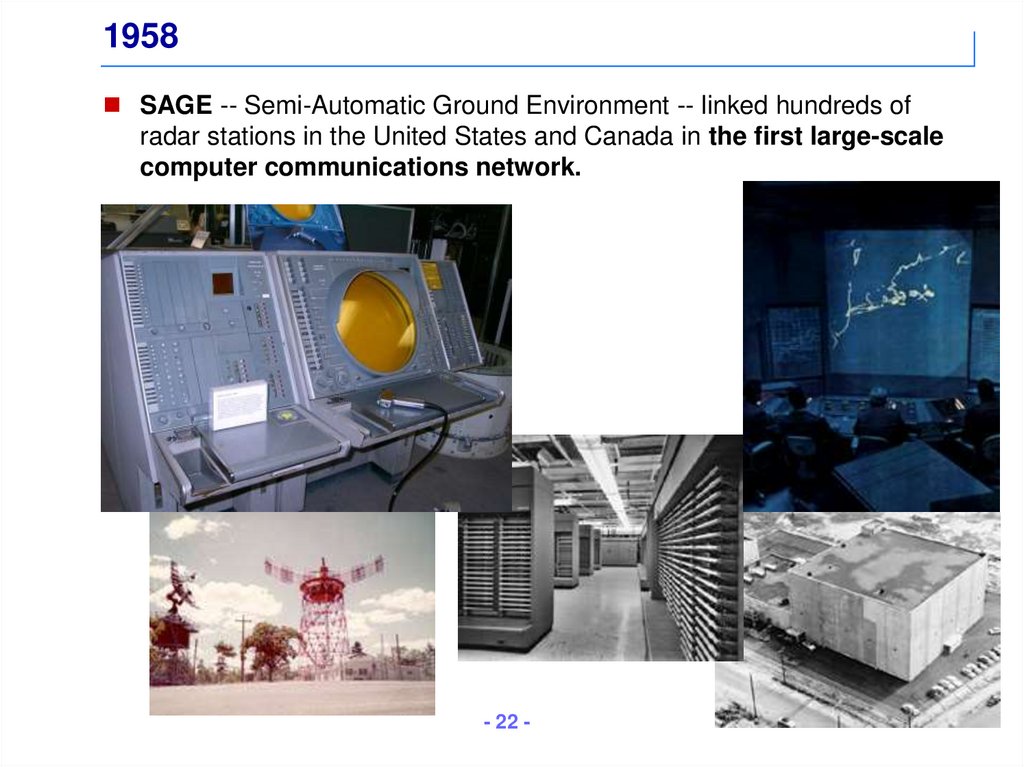






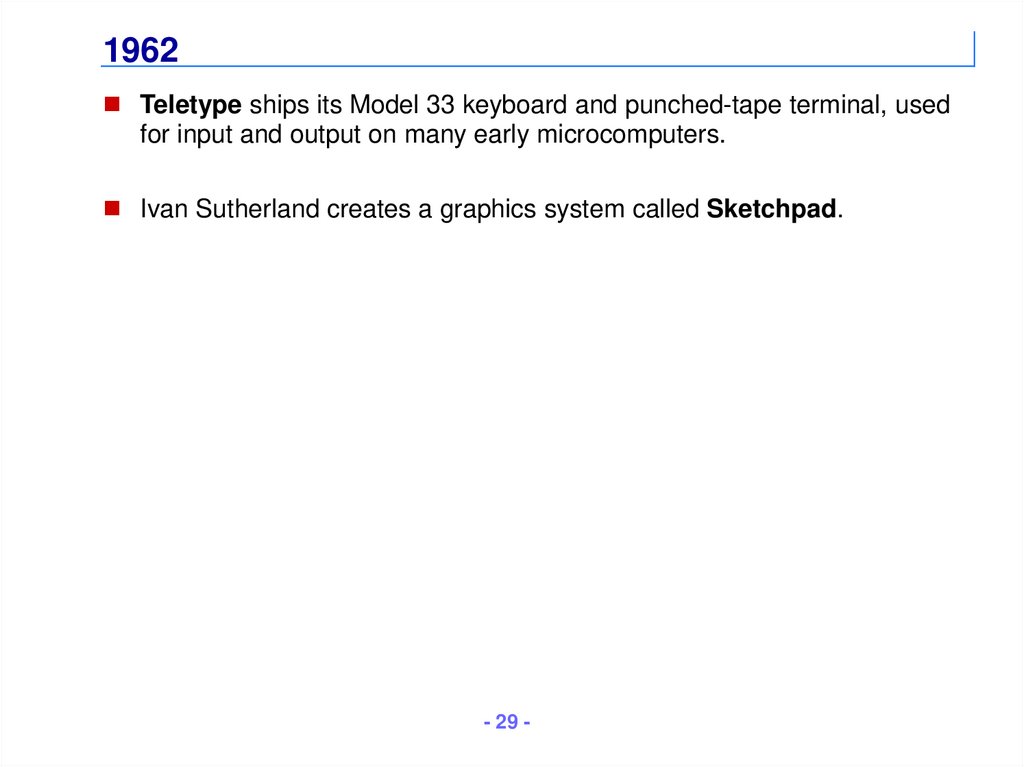
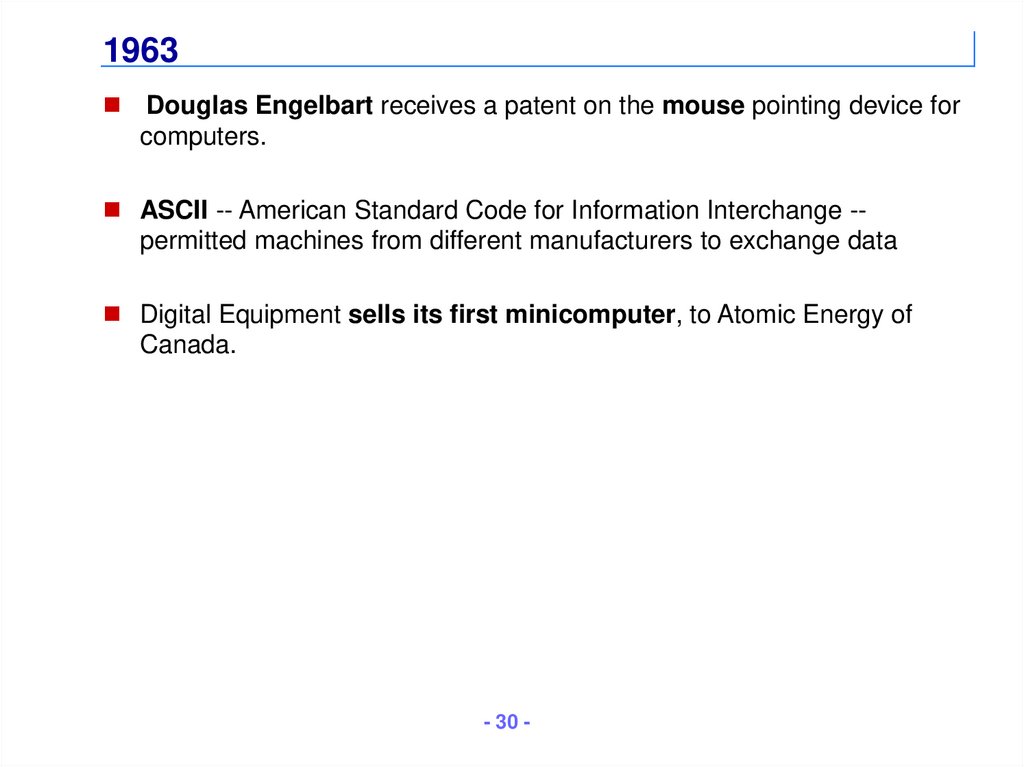
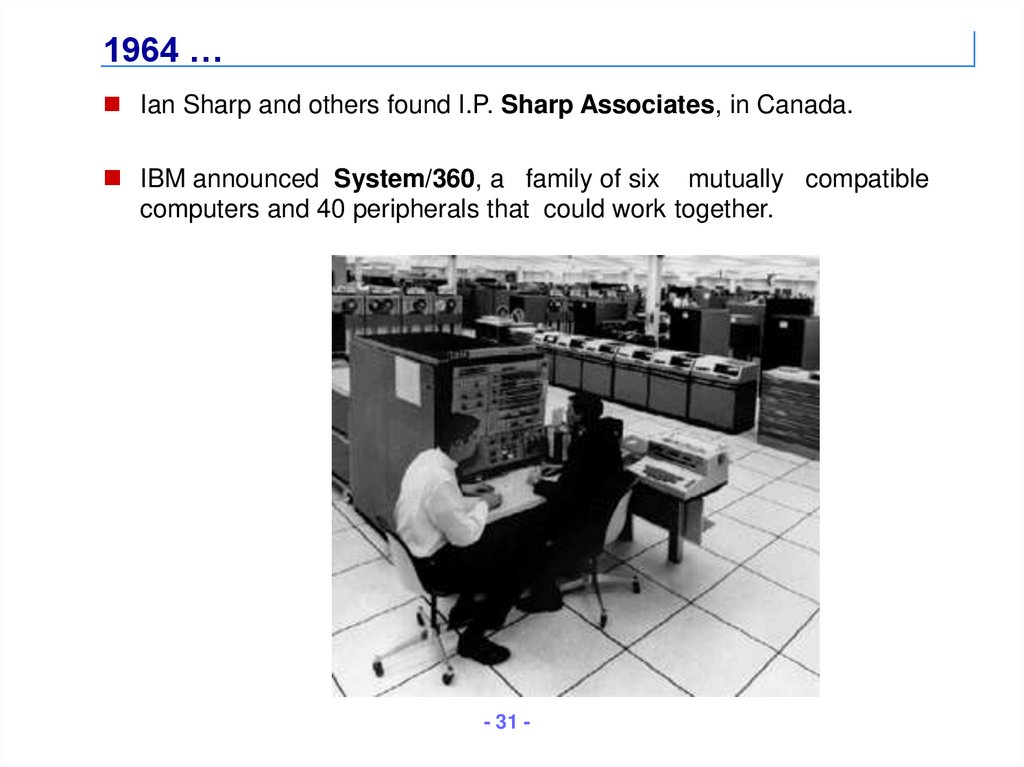




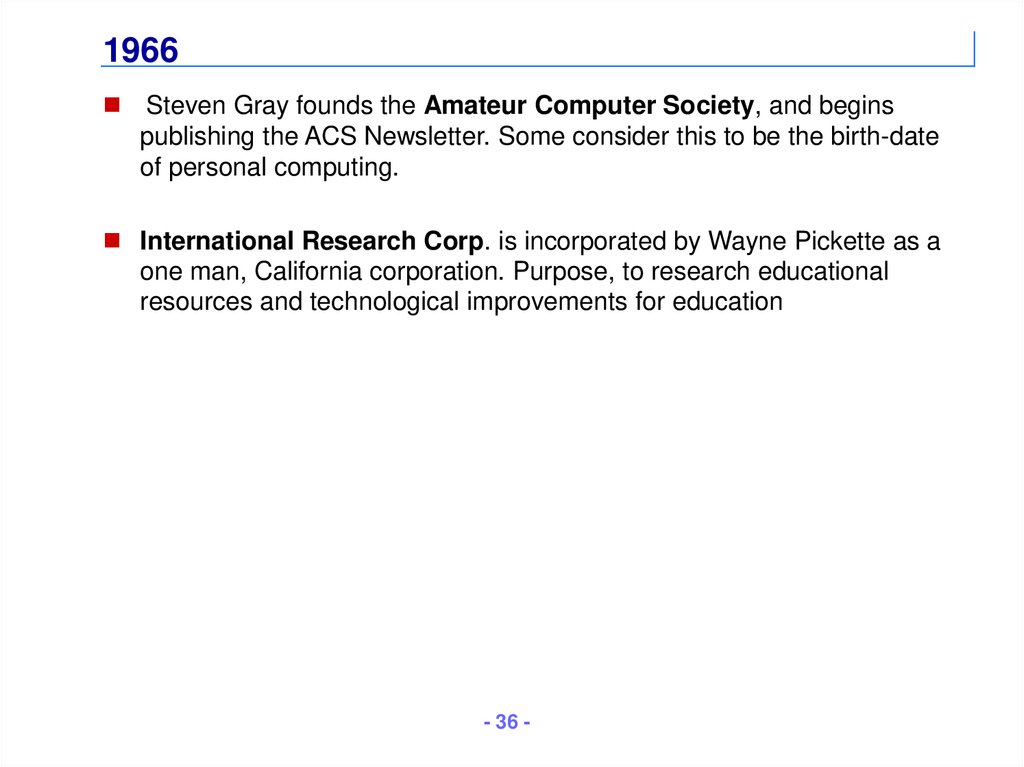
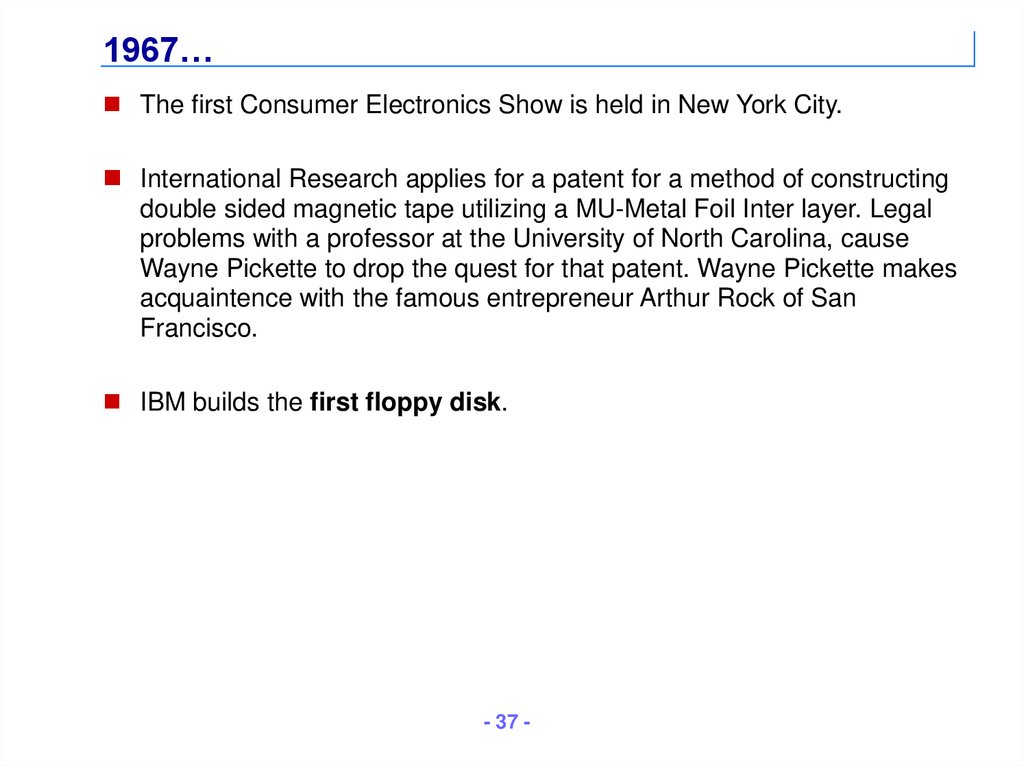







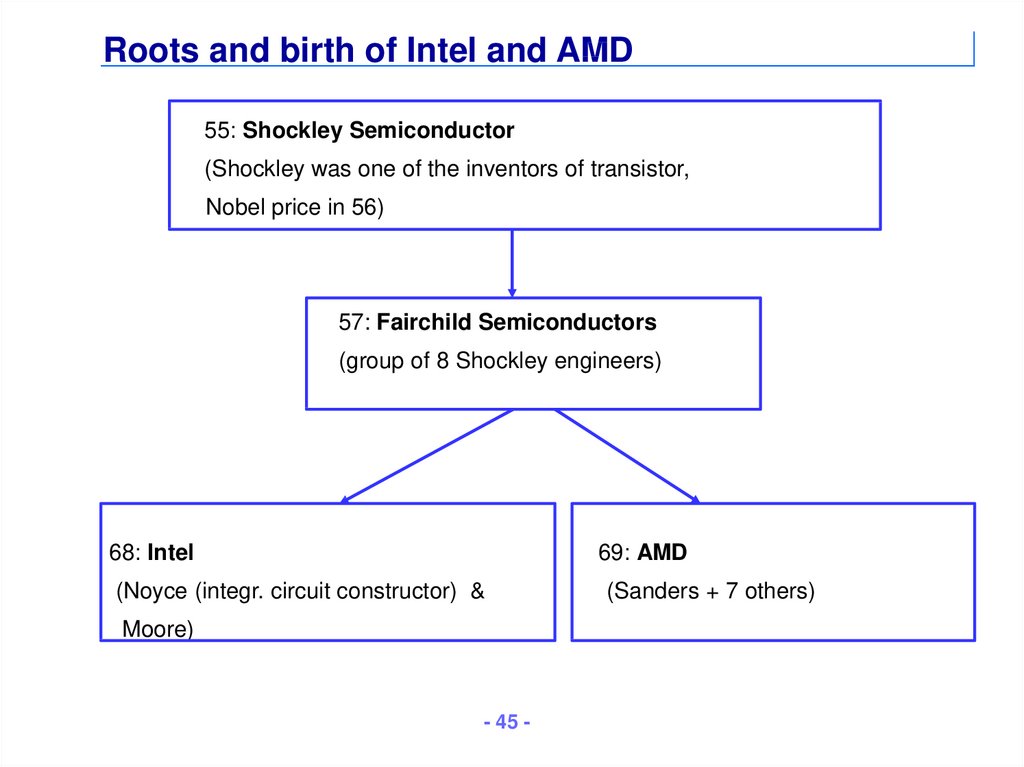
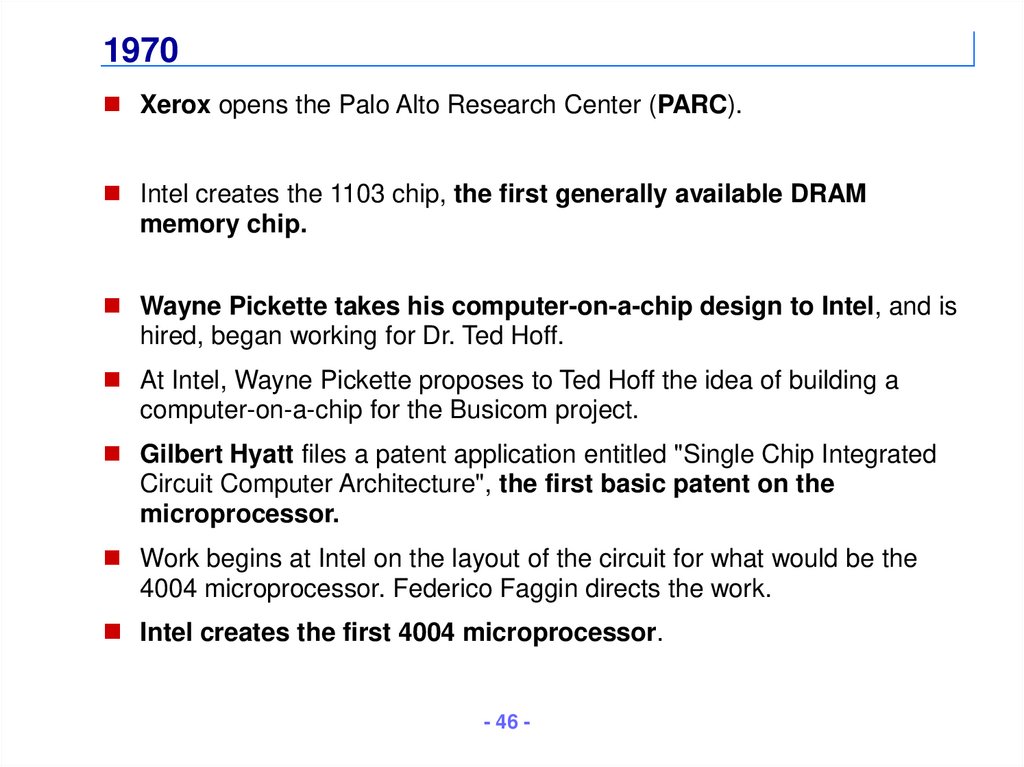

 programming
programming informatics
informatics